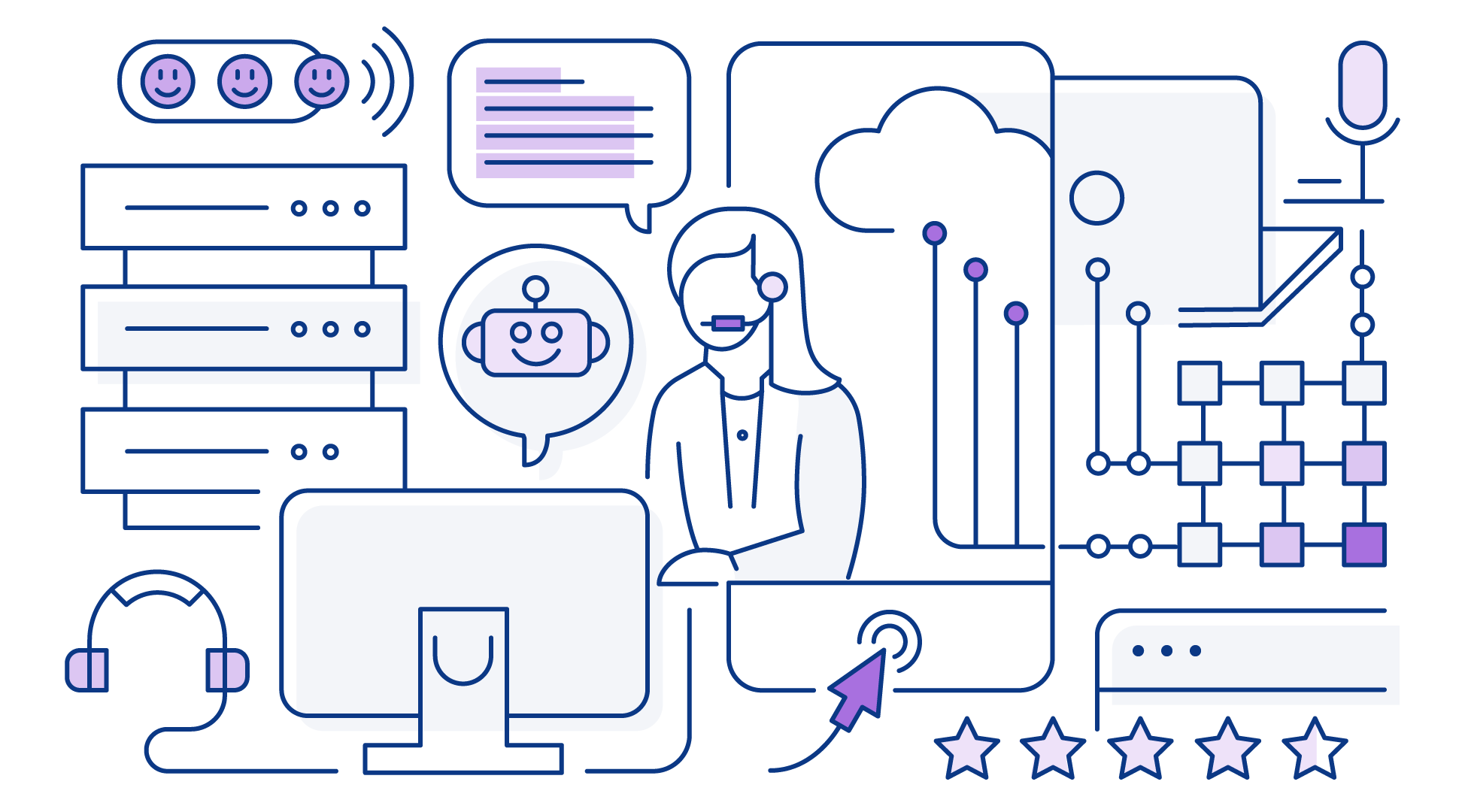Determining why customer satisfaction matters isn’t exactly rocket science. Satisfied customers are more loyal, more likely to advocate for your brand and – as a result of this – have higher customer lifetime value. (We’ve covered some more of the subtle ways satisfying customers is good for business in our last blog.)
As to the actual business of satisfying customers, while this, too, isn’t exactly rocket science (unless you’re SpaceX) it is increasingly being achieved via high-tech means.
There’s no shortage of cutting-edge technologies out there that can help improve your CSAT scores. But while this is certainly cause for excitement, that excitement should be tempered with a healthy dose of caution.
Go about implementing all this shiny new tech in the wrong way and you’ll find that technology can actually reduce customer satisfaction. Because the strange fact is that even some of the most sophisticated CX tech can drive a wedge between you and your customers – not least one of its most omnipresent forms …
When self-service satisfies …
Perhaps the most obvious way in which tech is being used to satisfy digital customers is by providing them with self-service options.
Customers increasingly expect self-service. In fact, according to a recent report, 81% of consumers want more self-service options than they’re currently being provided with.
And who can blame them? When customers need basic guidance or have relatively simple issues to troubleshoot, being able to self-serve can be both more convenient and efficient than getting support from a business.
Businesses get a lot out of self-service, too, of course. By taking the most simple (and therefore frequent) customer inquiries off the hands of their customer service teams, they save the cost of hiring and training a small army of agents.
Meanwhile, the agents they do employ can concentrate on solving the more complex and sometimes thorny customer problems that can really move the needle on customer satisfaction if handled correctly. Once a matter of providing a detailed FAQ page, the standard of self-service customers expect is now powered by highly sophisticated technology.
Along with help portals and documentation management, self-service now commonly draws on AI and Machine Learning. Algorithms can be deployed to analyze the behavior of each of your customers and serve them ‘next best action’ prompts which help them navigate around your website and/or app, and drive them in the direction of products, services and promotions that they’re likely to be interested in.
Then there are chatbots, which can actually substitute for customer service agents. Customers can have relatively sophisticated conversations with virtual agents and receive help and advice. At their best, chatbots can provide a self-service experience that feels like being served by a knowledgeable and friendly human.
Well: up to a point …
And when it falls short
The thing is, even when powered by the most cutting edge AI, chatbots have their limits.
They’re great at handling simple interactions, but when it comes to the more complicated, emotional stuff, they’re going to come up short. (Not least because the customer will know they’re talking to a chatbot when they want to talk to a person. In one study, 29% of customers said that scripted responses were the most frustrating aspect of Live Chat service.)
In fact, despite all the aforementioned sophisticated technology, self-service in general is of limited effectiveness. According to Gartner’s recent ‘Improve Knowledge Management for Support and Self-Service With Knowledge-Centered Service’ report:
“Both customers and companies want self-service as an option for resolving issues. But less than 9% of customers attempting to “self-solve” succeed and remain within the self-service environment.” Now: this isn’t necessarily a problem, provided you make it easy for your customers to get help from a human when self-service fails.
If you don’t make it easy, and customers feel they’re being forced to fend for themselves, they’ll stop feeling empowered by self-service. Instead, they’ll feel abandoned – and that’s a lot worse than merely feeling dissatisfied.
When overly relied on, self-service technology can actually have a counterproductive effect on customer satisfaction – and erect a wall between your business and its customers when it should be building a bridge. Luckily, there’s also tech out there that you can use to help your customers feel connected to your business across a digital divide.
The antidote: bringing in-store and in-person service online
VR and AR tech can be leveraged to make digital customers feel like they’re in their stores, or that their products are in their customer’s homes.
BMW’s Google Cloud powered AR enables shoppers to visit a virtual showroom via their phone or tablet, and even test drive their cars through VR goggles. Apple’s AR Quick Look, meanwhile, lets customers see what the latest iPhone or iMac models will look like in their personal spaces – or hands. Needless to say, this is all very satisfying for customers, giving them a taste of the in-store experience with all the couch-bound convenience of online shopping.
While not every single business stands to benefit from replicating a physical store experience in a digital space (although we’ve written elsewhere on this blog about how to take a leaf out of Apple’s book in this respect when designing onboarding experiences), every business can benefit from technology that makes it easier to serve customers, person-to-person, through digital channels.
Contact centers can now leverage a range of technologies to make life easier for their agents – and customer service more efficient and satisfying for their customers. (This is particularly important given that self-service is taking simple tasks out of agents’ queues and allowing them to focus on the more complicated cases.)
Unified agent desktops are removing friction for agents, putting relevant customer information at their fingertips and enabling them to manage multiple interaction channels through a single screen.
Agents can be further assisted by AI-powered suggestions for next best actions during interactions with customers, and AI-enhanced analysis of calls (including sentiment detection) that can guide their training and improve future interactions.
But while these technologies certainly help your agents deliver a more satisfying service, for the ultimate boost to agent-to-customer interactions, you’ll want to look at cobrowsing.
The most cutting-edge cobrowsing technologies make it easy for agents to resolve customer issues on-screen, without having to direct their navigation in the dark.
They enable your agents and customers to get on the same page within seconds (without any downloads or installations) and collaborate within your website or app, in real-time.
They let your agents see exactly what the customer is seeing (within your website or app) at all times, guide their navigation by highlighting elements for them and even – with the customer’s permission – take control of the customer’s browser.
They enable your agent to share their screen with the customer, so they can demonstrate how to carry out actions and share demos of products and services. (Plus any relevant documents.)
And they enable any-way video chat, so your customers and agents can look each other in the eye and quickly create the sort of emotional bond that a telephone conversation can’t.
In summary, they deliver a Guided Customer Experience that replicates the feeling of in-person service in a digital space. And that means more satisfied customers.
It’s time to come clean. (On the off chance you didn’t guess already.) When we say “the best cobrowsing technologies” we’re really only talking about one technology – because only one cobrowsing solution can deliver the Guided Customer Experience we’ve just described.
We’ll give you zero guesses.
Embedding more “human” into the user journey
Ultimately, customer satisfaction is about making life easy – and pleasant – for your customers. Self-service tech helps make life easy for customers, but it has severe limitations.
Once those limitations are reached, customer experience can rapidly become markedly unpleasant. To remain satisfied, customers need to be able to easily talk to a human representative of your business – in as efficient, valuable and enjoyable a manner as possible.
Our Guided CX technology helps businesses satisfy customers who can’t be satisfied by a clunky help or documentation site, a chatbot or a traditional contact center interaction. More than that, it helps delight those customers.
And it’s raised NPS and CSAT levels for clients across multiple industries. (Not to mention CLTV and revenue.) If you’d like to find out exactly how it does that, scoot over to our products page.





